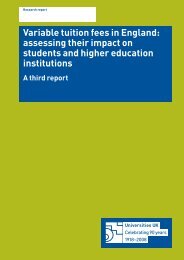Part-time Students And part-time Study In Higher ... - Universities UK
Part-time Students And part-time Study In Higher ... - Universities UK
Part-time Students And part-time Study In Higher ... - Universities UK
You also want an ePaper? Increase the reach of your titles
YUMPU automatically turns print PDFs into web optimized ePapers that Google loves.
3.1.2 The average costs of tuition/course fees standardised to full-<strong>time</strong> equivalentAs we have seen, students were studying for different qualifications and for a different number ofcredits in 2005/06 (Table 1.3). <strong>In</strong> order to standardise the costs of fees, we divided the fee given by astudent by the number of credit points 13 they were studying, and then multiplied this figure by 120.This gives a “fee per full-<strong>time</strong> equivalent (FTE)” for the whole academic year.<strong>In</strong> addition to the 218 students who do not know the amount of fees paid, there were 997 studentswho did not know the number of credit points they are studying for during the academic year and 55students who reported zero credit points. Thus, we can only calculate a full-<strong>time</strong> equivalent level oftuition fees for 1,384 students.• Again, there were wide variations in the costs of FTE fees – ranging from £0-£6,600, while thestandard deviation was £873.• Table 3.3 shows for those students surveyed who declared both a fee and the number of creditpoints studied, the mean fee per FTE over the academic year was £1,480. For half the studentsthe fees were less than £1,200 and for half, more than this sum. This is roughly equivalent to thefee of £1,175 set by the Government for 2005/06 for full-<strong>time</strong> students.• Tables 3.3 and 3.4 also show that the FTE costs of tuition varied by students’ key characteristicsand the nature of their course. The students with the most expensive FTE fees wereundertaking courses less than 50 per cent FTE while those with the cheapest FTE fees weretaking a course 75 per cent or more FTE.• Those groups of students incurring the highest fees, at least £100 above the average, are notnecessarily the same as the groups paying the highest non-standardised fees. They includedstudents:− undertaking courses of less than 50 per cent FTE – average FTE fees £1,958;− undertaking course lasting four or three years – average FTE fees £1,644 and £1,633respectively;− not on a distance learning course – average FTE fees £1,604; and− men – average FTE fees £1,582.• The finding that the most expensive courses are those constituting less than a half a full-<strong>time</strong>course is interesting. It suggests that there may be a financial premium for such courses.• Those students incurring the lowest FTE fees, at least £100 below the average, were:− undertaking courses of 75% FTE or more – average FTE fees £1,174;− not employed – average FTE fees £1,205;− on a course lasting six years or more – average FTE fees £1,274;− on a distance learning course – average FTE fees £1,286;− not studying towards a qualification – average FTE fees £1,28913 <strong>In</strong>tensity of study is based on data about the number of credit points undertaken during the academic year.There is some variation across institutions in the number of credit points that constitute 100 per cent FTE study.We have standardised 100 per cent FTE as 120 credit points. To do this we have multiplied reported creditpoints by 20 for any student reporting credit points of six or less. There were 124 students who reported six orfewer credit points. We have also set the number of credit points to be 120, where the reported credit pointswas 20 or less, but the level of fees charged was greater than £720. This applied to 14 students. A further 25students reported credit points of more than 120, which indicates an intensity of study that was greater than 100per cent of full-<strong>time</strong> study.<strong>Part</strong>-<strong>time</strong> students and <strong>part</strong>-<strong>time</strong> study: Strand 3 <strong>Universities</strong> <strong>UK</strong> 27
















